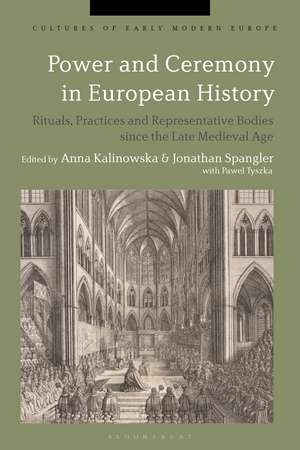Power and Ceremony in European History: Rituals, Practices and Representative Bodies since the Late Middle Ages: Cultures of Early Modern Europe
Editat de Anna Kalinowska, Dr Jonathan Spangleren Limba Engleză Paperback – 19 apr 2023
| Toate formatele și edițiile | Preț | Express |
|---|---|---|
| Paperback (1) | 192.01 lei 6-8 săpt. | |
| Bloomsbury Publishing – 19 apr 2023 | 192.01 lei 6-8 săpt. | |
| Hardback (1) | 569.60 lei 6-8 săpt. | |
| Bloomsbury Publishing – 6 oct 2021 | 569.60 lei 6-8 săpt. |
Preț: 192.01 lei
Preț vechi: 249.72 lei
-23% Nou
Puncte Express: 288
Preț estimativ în valută:
36.75€ • 38.22$ • 30.75£
36.75€ • 38.22$ • 30.75£
Carte tipărită la comandă
Livrare economică 14-28 martie
Preluare comenzi: 021 569.72.76
Specificații
ISBN-13: 9781350268869
ISBN-10: 1350268860
Pagini: 288
Ilustrații: 26 bw illus
Dimensiuni: 156 x 234 x 25 mm
Greutate: 0.37 kg
Editura: Bloomsbury Publishing
Colecția Bloomsbury Academic
Seria Cultures of Early Modern Europe
Locul publicării:London, United Kingdom
ISBN-10: 1350268860
Pagini: 288
Ilustrații: 26 bw illus
Dimensiuni: 156 x 234 x 25 mm
Greutate: 0.37 kg
Editura: Bloomsbury Publishing
Colecția Bloomsbury Academic
Seria Cultures of Early Modern Europe
Locul publicării:London, United Kingdom
Caracteristici
Builds on current debates by broadening the geographic scope to include the Ottoman Empire and taking the analysis up to the modern day
Notă biografică
Anna Kalinowska is Senior Researcher in the Institute of History at Polish Academy of Sciences, Poland.Jonathan Spangler is Senior Lecturer in History at Manchester Metropolitan University, UK. He is the author of The Society of Princes (2009) and editor of The Court Historian.Pawel Tyszka is Head of Historical Research at The Royal Castle in Warsaw, Poland.
Cuprins
List of IllustrationsList of TablesList of ContributorsIntroduction, Anna Kalinowska (Polish Academy of Sciences, Poland) and Jonathan Spangler (Manchester Metropolitan University, UK)Part I. Coronation and Enthronement1. Where exactly is the throne? Locating sovereignty in sixteenth-century Ottoman succession rituals, N. Zeynep Yelce (Sabanci University, Turkey)2. Proclamations and coronations in Palermo (1700-1735): Performing kingship and celebrating civic power, Pablo González Tornel (Universitat Jaume I, Spain)3. Nicholas Dixon, The evolution of the British coronation rite, 1761-1953, Nicholas Dixon (Independent Scholar, UK)Part II. Ceremonial of Royal Courts4. The daily court ceremonial of the French queen in the reign of Henry III, Vladimir Shishkin (Saint Petersburg State University, Russia)5. Courtly and ceremonial spaces in Spanish Royal Sites: an evolution from the Renaissance to the Baroque, José Eloy Hortal Muñoz (University Rey Juan Carlos, Spain)6. Royal baptism in the Spanish court: art and ritual from the sixteenth to the eighteenth century, Inmaculada Rodríguez Moya (Universitat Jaume I, Spain)7. From Marshal to Monarch. State ceremonies and Jean-Baptiste Bernadotte in post-Napoleonic Sweden, Mikael AlmPart III. Ceremonial of Institutions and Representative Bodies8. Not the ruler, but the land: Estates and ceremonial order at the Diet of Besztercebánya, 1620, Gábor Kármán (Institute of Hungary in Budapest, Hungary)9. Oath-taking and hand-kissing: ceremonies of sovereignty in a "Monarchia composita", the States of the House of Savoy from the sixteenth to the nineteenth century, Andrea Merlotti (Centro studi delle Residenze Reali Sabaude, Italy)Part IV. Tangible and Intangible Elements in Staging Ceremonies10. Jagiellonians and Habsburgs: heraldic dynastic representation in Central Europe from the fifteenth to the seventeenth century, Géza Pálffy (Institute of Hungary in Budapest, Hungary)11. Operas and masquerades: court rituals and entertainments under Ernest Augustus and George I of Brunswick-Lüneburg (1660-1727) in the Electorate of Hanover and Great Britain, Babara Arciszewska (University of Warsaw, Poland)12. Public staging, visualization and performance of eighteenth-century Danish absolutism: Queen Caroline Mathilde's journey across Funen as ritual, Michael Bregnsbo (University of Southern Denmark at Odense, Denmark)Select BibliographyIndex
Recenzii
Power and Ceremony in European History is highly recommended as a series of case studies demonstrating the richness of the ritual approach to European politics and power. Researchers and students will find a wealth of examples of how sociological and anthropological analyses can elucidate the meaning and significance of the frequent power performances that animated premodern monarchies.
This wide-ranging collection of essays explores the significance of many different kinds of ceremony, both in everyday life and during major occasions like coronations and royal funerals, in early modern courts throughout Europe, from the Ottoman Empire to Scandinavia and Britain. It makes a welcome contribution to the field of court studies.
A fascinating, must-read addition to the bibliography on court studies... Anna Kalinowska and Jonathan Spangler have assembled a rich array of essays with an impressive geographical and chronological range, introduced by a text which for all its brevity sets a standard in the field. Any court historian grappling with the notions of ceremonial and ritual, their interaction with space and material objects, and their use as a form of communication at the (early) modern courts, will discover inspiring case studies in this collection.
This wide-ranging collection of essays explores the significance of many different kinds of ceremony, both in everyday life and during major occasions like coronations and royal funerals, in early modern courts throughout Europe, from the Ottoman Empire to Scandinavia and Britain. It makes a welcome contribution to the field of court studies.
A fascinating, must-read addition to the bibliography on court studies... Anna Kalinowska and Jonathan Spangler have assembled a rich array of essays with an impressive geographical and chronological range, introduced by a text which for all its brevity sets a standard in the field. Any court historian grappling with the notions of ceremonial and ritual, their interaction with space and material objects, and their use as a form of communication at the (early) modern courts, will discover inspiring case studies in this collection.












